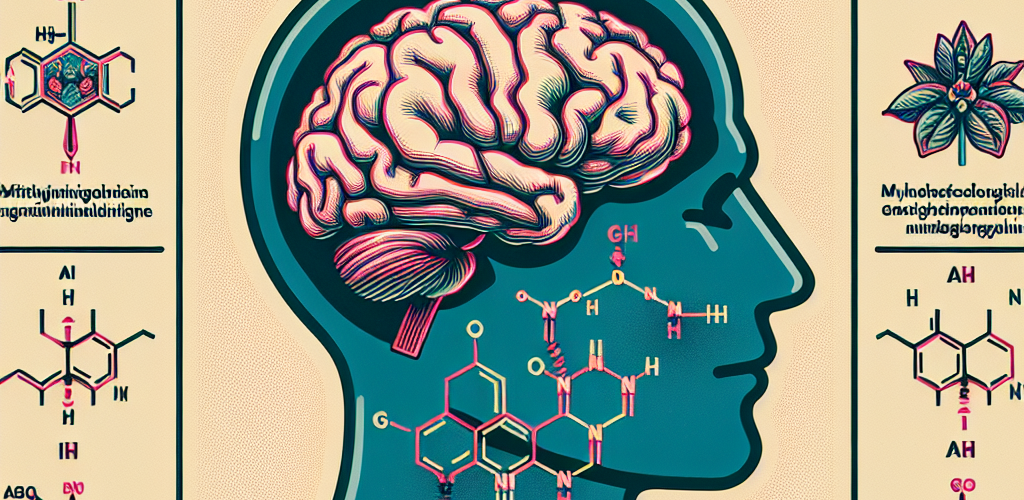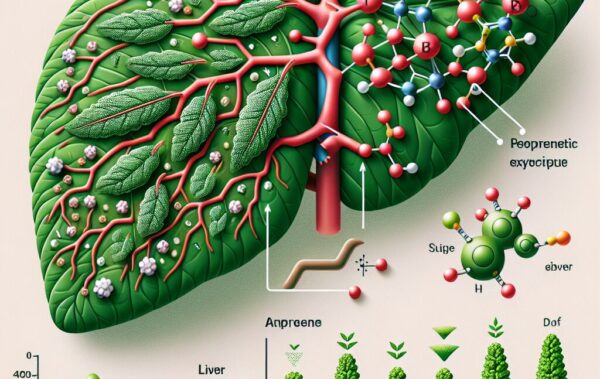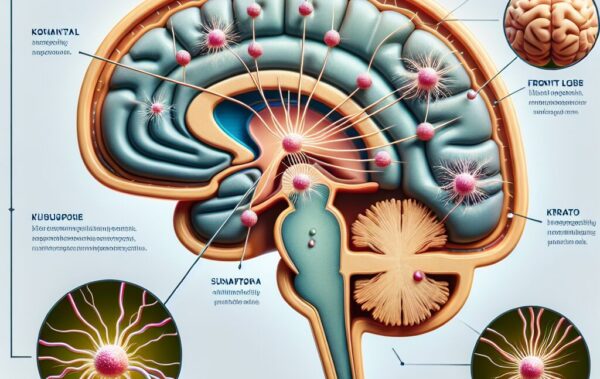- Kratom’s alkaloid profile: Understanding the compounds
- How mitragynine influences neurochemistry
- 7-hydroxymitragynine and its unique impact on the brain
- The potential therapeutic applications of kratom’s alkaloids
- Frequently Asked Questions about kratom and its alkaloids
Kratom, a tropical evergreen native to Southeast Asia, has caught the attention of both researchers and the general public due to its intriguing alkaloid profile. These naturally occurring compounds are the primary reason for the effects attributed to kratom leaves, which have been used traditionally for centuries by local populations. At the forefront of kratom’s alkaloid makeup are mitragynine and 7-hydroxymitragynine, which have been identified as the most potent and influential on the brain. However, kratom’s effects are the result of a symphony of over 40 different alkaloids, each with varying degrees of impact.
The interplay between these alkaloids and the body’s neurochemistry is a multifaceted process. When consumed in forms such as kratom powder, capsules, or tea, these alkaloids interact with opioid receptors in the brain. Remarkably, despite their interaction with opioid receptors, the alkaloids in kratom produce effects that are distinct and have a lower risk profile than classical opioids. This is largely due to their diversity and the complexity of their action within the brain’s neurological pathways.
In addition to mitragynine and 7-hydroxymitragynine, other alkaloids like speciogynine, paynantheine, and speciociliatine also play roles, albeit less pronounced. These compounds are thought to contribute to the subtler, more nuanced effects of kratom, such as its muscle relaxant and anti-inflammatory properties. Understanding the full spectrum of kratom’s alkaloid profile is crucial as this will help in docking the fine line between use and misuse and in elucidating potential therapeutic benefits.
Here’s a simplified breakdown of how these alkaloids impact the brain:
- Mitragynine: Interacts mainly with μ-opioid receptors but is also thought to affect other neurotransmitter systems, which could explain the stimulant properties observed at lower doses.
- 7-hydroxymitragynine: More potent than mitragynine and known for its interaction with opioid receptors, thus more closely associated with analgesic and sedative effects.
- Speciogynine and Paynantheine: Associated with smooth muscle relaxation.
- Speciociliatine: A weak opioid agonist, thought to complement the effects of mitragynine and 7-hydroxymitragynine.
A deeper dive into the precise mechanisms by which these alkaloids affect the brain is still underway, as researchers strive to demystify the pharmacology of this complex botanical. The diversity of alkaloids present in kratom reflects the necessity for a sophisticated approach in research to discern not only their individual effects but also how they may synergize or antagonize each other. Such understanding could pave the way for the development of novel treatments for a variety of conditions.
| Alkaloid | Potential Effects |
|---|---|
| Mitragynine | Stimulant at low doses, sedative at high doses |
| 7-hydroxymitragynine | Analgesic, sedative |
| Speciogynine | Muscle relaxant |
| Paynantheine | Muscle relaxant |
| Speciociliatine | Modulates opioid effects |
Continuing to explore kratom’s alkaloids offers a window into understanding not only the effects on the brain but also the potential for its constituents to provide value in therapeutic settings. As research evolves, it could facilitate the development of more targeted and safe applications of kratom’s bioactive components. Whether looking to understand its traditional use or considering it for personal use, appreciating the intricacies of kratom’s alkaloid profile is an essential step. This forms the basis for informed decision-making when browsing through kratom offerings, such as those on our marketplace platform that features numerous kratom products from various brands.
How mitragynine influences neurochemistry
Mitragynine is undoubtedly the most prolific alkaloid found within kratom leaves and serves as the plant’s primary active compound. It operates through a complex interaction with the brain’s neurochemical systems, invoking a host of physiological effects.
The intricacies of mitragynine’s effects on neurochemistry are fascinating, primarily due to its action on the μ-opioid receptors (MOR). While this alkaloid does indeed engage these receptors, it does so in a way that is markedly different from traditional opioids. Mitragynine is classified as a partial agonist at these receptors, meaning it activates them but to a lesser extent than full agonists such as morphine or heroin. This partial activation is crucial, as it is thought to contribute to kratom’s lower incidence of respiratory depression, a common and dangerous side effect of conventional opioids.
But that’s not the whole story. Unlike its opioid counterparts, mitragynine’s interaction with the brain does not stop at the opioid receptors. It also modulates the release of neurotransmitters like dopamine and serotonin. These neurotransmitters are key players in mood regulation, and their modulation may offer an explanation for the mood-lifting effects experienced by some kratom users. At lower doses, users often report feeling increased energy and alertness, effects that are likely tied to mitragynine’s stimulatory impact on the central nervous system.
The dose-dependent nature of mitragynine’s effects cannot be overstated. At those lower doses, it may produce stimulation, while higher doses are associated with more sedative and analgesic effects. This feature highlights the importance of precise dosing for individuals looking to utilize kratom for specific purposes. Users can find a variety of kratom products, such as kratom powders and capsules, which are convenient for controlling intake.
Yet another factor contributing to mitragynine’s distinctive effects on the brain is its influence on adrenergic receptors. By interacting with these receptors, mitragynine may exert a sympathomimetic effect, possibly leading to the mild increase in heart rate and blood pressure that some users experience.
It is essential, though, to approach the consumption of kratom and its alkaloids with a sense of responsibility and moderation. While the unique profile of mitragynine may not lead to the same level of dependency as classical opioids, tolerance and dependence can still occur with frequent and heavy use.
Understanding the breadth of mitragynine’s effects on the neurochemistry of the brain provides invaluable insight into the alkaloid’s potential and the complexities of kratom as a whole. Each user’s experience can vary widely, dictated by individual physiology, the specific kratom strain, and the dosage consumed. For those interested in the analgesic properties of kratom, it would be worthwhile to explore other strains known for their high concentration of mitragynine, such as Maeng Da.
With ongoing research and a growing body of user-reported data, the scope of knowledge about mitragynine and its effects on the brain continues to expand, promising new insights into how this complex alkaloid may be harnessed for wellbeing.
7-hydroxymitragynine and its unique impact on the brain
Moving beyond mitragynine, another noteworthy compound within the kratom alkaloid panorama is 7-hydroxymitragynine. This alkaloid is structurally similar to mitragynine but displays a unique pharmacological profile that warrants special attention. While it occurs in much smaller quantities in the kratom plant, 7-hydroxymitragynine has garnered attention for its potent effects on the brain, often more pronounced than those of mitragynine.
When introduced to the human body, 7-hydroxymitragynine exhibits a high affinity for binding to the μ-opioid receptors, more so than mitragynine. This higher affinity translates into stronger analgesic properties, making it a primary contributor to the pain-relieving effects attributed to kratom use. As with other opioids, this interaction can also promote feelings of relaxation and euphoria. However, it is this same potency that underscores the need for understanding and cautious use.
The effects of 7-hydroxymitragynine don’t occur in isolation; they are part of a more comprehensive response that involves multiple receptor sites and neurotransmitter systems. What is particularly intriguing is the potential entourage effect—whereby the range of alkaloids present in kratom may interact synergistically to modulate its overall impact on the body and brain. The role of 7-hydroxymitragynine within this entourage effect is a critical area of study to unravel the compound’s precise contribution to kratom’s effects.
Given its potency, the risk of developing tolerance to 7-hydroxymitragynine may be higher, raising considerations about use patterns and potential withdrawal symptoms. Studies have also suggested that the sedative effects of 7-hydroxymitragynine are more significant than the stimulatory effects seen with low-dose mitragynine, which underscores the importance of dosage management.
For users seeking the therapeutic benefits associated specifically with 7-hydroxymitragynine, particularly its strong analgesic properties, it is essential to select kratom strains known for containing higher concentrations of this alkaloid. For instance, some individuals opt for Red Vein kratom powders, which are often reported to have higher levels of this compound.
As with all components of kratom, the decision to use products containing 7-hydroxymitragynine should be thought about carefully, weighing potential benefits against risks. In the ever-evolving discourse on kratom, understanding the impact of 7-hydroxymitragynine on the brain remains a subject of significant scientific inquiry, with potential implications for both therapeutic applications and policy-making.
Research into 7-hydroxymitragynine and its effects on the brain is ongoing, but the knowledge gained so far indicates a complex interaction that may hold keys to developing novel pain management strategies. Importantly, as the legal status of kratom varies across regions, users should stay informed about regulations and standards pertaining to kratom-related products to ensure safe and responsible use.
The potential therapeutic applications of kratom’s alkaloids
 Continuing our exploration into the fascinating realm of kratom and its alkaloids, it’s imperative to consider their potential therapeutic applications. The primary alkaloids, mitragynine and 7-hydroxymitragynine, have demonstrated various effects on the brain that could lead to beneficial treatments for a wide range of conditions.
Continuing our exploration into the fascinating realm of kratom and its alkaloids, it’s imperative to consider their potential therapeutic applications. The primary alkaloids, mitragynine and 7-hydroxymitragynine, have demonstrated various effects on the brain that could lead to beneficial treatments for a wide range of conditions.
One exciting avenue is pain management. Traditional over-the-counter painkillers and prescription opioids come with a risk for side effects and addiction, respectively. However, due to kratom’s interaction with opioid receptors—albeit with a distinct and seemingly safer profile—it has the potential to offer a natural alternative for managing pain. Studies have pointed to 7-hydroxymitragynine, in particular, as a potent analgesic that might be useful for chronic pain sufferers when used responsibly. This hypothesis is bolstered by numerous anecdotal reports from individuals who have found relief from pain by using various kratom products, including kratom extract powder.
Another possible therapeutic application concerns mood disorders. Users and preliminary research suggest that the modulation of neurotransmitters by kratom’s alkaloids may have anti-anxiety and antidepressant effects. The improvement of mood and the relief of depressive symptoms could make kratom a valuable tool in the mental health toolbox, especially for those who have not found success with conventional treatments.
In addition, the stimulant effects observed at lower doses of mitragynine might provide a novel approach to combating fatigue and enhancing focus, which may benefit those with attention-deficit disorders or general lethargy. Such stimulatory properties have made kratom a popular choice for those requiring a boost in energy and concentration, akin to the effects that coffee provides but perhaps with a different pharmacological profile.
However, the potential applications of kratom’s alkaloids are not without their challenges and controversies. The lack of comprehensive clinical research and the uncertain regulatory environment surrounding kratom use in many places pose obstacles to fully realizing and harnessing these therapeutic potentials. Issues of proper dosing, standardization of kratom products, and the prevention of misuse are all areas that must be addressed by the scientific community and regulatory agencies.
Consumer education is also critical. As kratom gains popularity, users should be aware of the importance of sourcing high-quality, lab-tested products from reputable vendors. Those interested in exploring the potential pain-relieving effects of kratom could consult products like Red Vein kratom capsules, known for their higher mitragynine content.
Understanding the therapeutic potential of kratom’s alkaloids is an evolving process that holds promise for future medical applications. It’s crucial to continue this scientific exploration while fostering a dialogue between researchers, health professionals, users, and policymakers to ensure that any therapeutic benefits can be maximized while minimizing risks.
| Condition | Potential Kratom Alkaloid Application |
|---|---|
| Pain Management | Analgesic effects, particularly from 7-hydroxymitragynine |
| Mood Disorders | Modulation of neurotransmitters like serotonin and dopamine |
| Fatigue and Attention-Deficit Disorders | Stimulant effects at lower doses of mitragynine |
As discussions on kratom’s potential therapeutic benefits continue in academic and medical spheres, there remains a significant interest from the public in understanding not only the recreational but also the possible health-oriented applications of this botanical. With sustained research and responsible use, kratom’s alkaloids may one day be integrated into broader treatment paradigms, offering new hope for those seeking alternative therapies.
Frequently Asked Questions about kratom and its alkaloids
Q: What are kratom’s alkaloids, and why are they significant?
A: Kratom’s alkaloids are natural bioactive compounds that are primarily responsible for the plant’s effects on the brain and body. Mitragynine and 7-hydroxymitragynine are the most notable, associated with pain relief, mood enhancement, and stimulant or sedative effects. They are significant because they may offer potential therapeutic benefits that differ from conventional treatments.
Q: Can kratom be used as a treatment for mood disorders?
A: Some users report mood improvement when using kratom, and preliminary research suggests that kratom’s alkaloids may affect neurotransmitters related to mood regulation. However, more scientific research is necessary to fully understand its efficacy and safety in treating mood disorders.
Q: Is it safe to use kratom for pain management?
A: Kratom is being explored as a potential natural alternative for pain management, especially due to its alkaloids’ anal
Frequently Asked Questions about kratom and its alkaloids
A: Kratom is being explored as a potential natural alternative for pain management, especially due to its alkaloids’ analgesic properties. While many users have reported positive experiences, safety may vary per individual, and considerations of dosage, frequency of use, and possible interactions with other substances are important. Always consult a healthcare professional before using kratom for medicinal purposes.
Q: Are there potential side effects of using kratom?
A: Yes, like all substances, kratom can cause side effects, especially when used in excessive amounts. Reported side effects may include nausea, dry mouth, loss of appetite, constipation, and dependence or withdrawal symptoms after prolonged use. The variety of kratom, such as whether it is Green Vein or Red Vein, can also influence its effects.
Q: How do the effects of kratom alkaloids compare to the effects of opioids?
A: Kratom alkaloids, primarily mitragynine and 7-hydroxymitragynine, interact with opioid receptors but with different degrees of stimulation compared to classic opioids. They are partial agonists, which may result in a lower risk of respiratory depression, one of the most dangerous side effects of opioids. However, effects and risks can be dose-dependent, and research is still ongoing to fully compare their profiles.
Q: What should someone consider before trying kratom?
A: Before trying kratom, individuals should consider the legality of kratom in their area, quality and testing of kratom products, potential interactions with other medications or health conditions, the reasons for using kratom, and the importance of beginning with a conservative dose. Exploring options like Malay Kratom powder for more gradual effects could also be beneficial. Consulting a healthcare provider for medical advice is always recommended.
Q: Can kratom lead to addiction?
A: While kratom is not an opioid, its alkaloids act on opioid receptors, which means there’s a potential for dependence and addiction, similar to opioids. Users should approach kratom mindfully, with awareness of their consumption habits to mitigate the risk of developing dependency.
Q: How do I find reliable kratom products?
A: To find reliable kratom products, look for vendors that offer lab-tested products and transparently provide product origins and alkaloid content. For example, buyers may consider starting with trusted offerings such as kratom powders or extracts from reputable sources.
Remember, while kratom has been used traditionally for its effects on the brain and body, there’s still much to learn about its alkaloid profile and its long-term impacts. The information provided here reflects the knowledge as of the current date and is not a substitute for professional medical advice.









